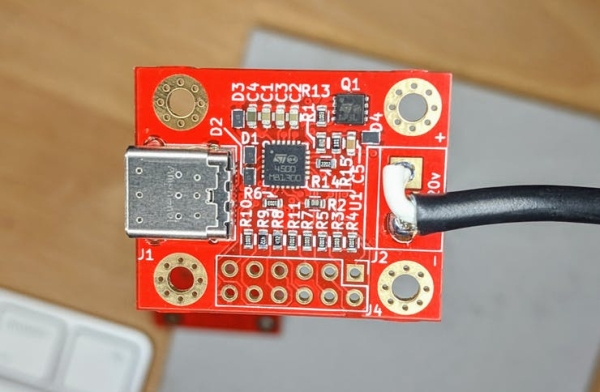Modern devices are quickly switching to USB-C power adapters, gradually fading out USB-A, and USB-B adapters. USB’s Power Delivery (USB-PD) protocol enables the supplies to be flexible enough to handle charging (or powering) devices ranging from mobile phones to laptops. There are many high quality 90-100 Watt USB-C power adapters available. But unfortunately, there are many devices that rely on legacy power bricks, that cannot function with those. Oxplot‘sUSB PD standalone controller bridges the gap. A STUSB4500 from STMicroelectronics handles the USB-PD protocol.

Ever thought of (re-)using your USB-C charger (like Macbook’s) to power other devices? If so, this is the board for you. You can configure the chip once with your voltage/current needs and it will automatically request that voltage/current from an upstream USB-C charger. This is completely stand-alone and requires no external microcontroller.
The STUSB4500 has memory for 3 Power Delivery Output (PDO) configurations, with each specifying an accepted voltage range and maximum current requirement. For example, one PDO can specify 13.2v±5% and max. current of 2.1A. Once configured, the chip will compute the list of available outputs upon cable attachment, and will match the requirements against it. If a match is available, it will configure the upstream to enable that power option. By virtue of the board featuring a MOSFET on the VBUS controlled by STUSB4500, it is possible to configure it to only pass through the power if the requirements are met (instead of fall back to another PDO or 5v). With the datasheet, the official GUI config tool exposes all the configuration in a simple to understand manner.
Features:
- STUSB4500 chip capabale of negotiating from 5-20V in 50mV increments and up to 5A.
- an LDO MOSFET power path that is switched on only when the charger meets the voltage/current requirements programmed.
- a discharge path to safely discharge the VBUS line when a lower voltage is configured or when the cable is detached.
- ESD protection diodes on VBUS and USB-C pins.
- Grounded M3 mounting holes.
- Optional header pins and screw terminal (requires soldering)
- Manufactured and assembled in USA
STUSB4500 features some simple but useful connectivity via open-drain IO pins, in addition to the I2C. Two of its 3 PDOs have dedicated pins that are pulled low when that PDO is selected. These can be connected to LEDs to indicate which voltage is selected. In addition, attachment and the side of the attached USB-C cable are indicated with dedicated pins. One GPIO pin can also be configured to indicate other conditions. Oxplot‘s breakout board enables either screw terminals or soldering wires directly to the board. Available also are ESD diodes on the USB side for protection. The board also utilizes a pass-transistor to ensure the DC port is powered until the STUSB4500 identifies a valid power configuration.
Read more: USB-PD STAND-ALONE ADAPTER BOARD FROM OXPLOT
